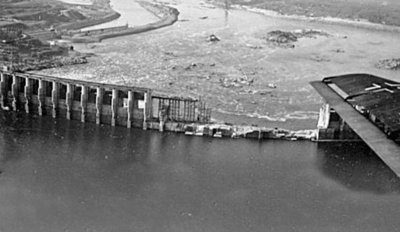For the Russians to have blown up the Kakhovka dam they would have needed to move tons of explosives using boats or underwater equipment, put explosives on the dam facing the reservoir and set off a massive explosion. From the video posted by the Ukrainian government, it looks like the explosions happened below the waterline.

The Kakhovka Dam is a hydroelectric power station. When operating it provided 357 mw of power and cooling water for the 5.7 gigawatt Zaporizhzhia nuclear power plant. It also supplied water for agriculture in southern Ukraine and northern Crimea.
When the Crimean Kerch Strait bridge was blown, there was a truck that blew up on the bridge and an attempt to blow the supporting pillars of the bridge using an underwater vehicle. The main bridge pillar did not fall, meaning the explosive power from the underwater explosion was not sufficient to do the job. The bridge was not bombed by aircraft, glide bombs or missiles.
There are few if any weapons that could break the dam. Moreover, it is unlikely that a large bomb could cause the sort of damage we are seeing on video.
It should be noted that in May and June the Ukrainians were firing missiles and artillery shells at the dam. It is claimed these attacks caused some cracks in the dam.
Zelensky may have sort of given away the game about the dam when he said it was an inside job. He meant by the Russians – and indeed there is a precedent: Stalin’s forces bombed what was then the world’s third largest dam on the same river in 1941 to try to slow the German advance through Ukraine.

But it’s hard to see what the Russians might have expected to gain this time. And it’s remarkable that one of the earliest pieces of news to emerge from the Kakhovka Dam blast is that the Ukrainians sent dozens of boats to pick up personnel from islands, downstream from the dam, that were being flooded out.
Organizing such a rescue so quickly suggests these relief assets were prepared and ready for action – and indeed the Ukrainians say they had prepared for just such an eventuality.
The Russians say they did not blast the dam and had no reason to do so.
They know that striking the dam could cause severe problems for the Zaporizhzhia nuclear power station, which needs great amounts of cooling water. This power plant is the largest one in Europe and is under Russian control. It still isn’t clear whether the power plant is any longer safe.
The dam break also threatened Russians’ defensive works in the areas that they hold near the river below the dam, territory that Ukraine has been trying to take back.
The Russian news source Sputnik Global has put out a long article in the form of a “fact check” saying that the dam was hit by the Ukrainians.
No doubt the Russians felt compelled to push back as the Western press swallowed Zelensky’s claim that Russia did it, headlining the claim on virtually all wire services and major newspapers. Following the initial trove of articles blaming Russia, papers like the New York Post are saying Putin is trying to destroy the Zaporizhzhia nuclear plant:
‘Lunatic’ ‘Terrorist’ Putin is turning plant into improvised nuke, ex-military official warns
New york post
It is hard to see how the dam explosion benefits Russia.
It is true that Ukrainian military folks on the small islands in the river had to leave, but when the water subsides they will come back.
The only seemingly unexpected result is that it was the top section of the dam that was destroyed. The lower portion is still in place meaning that not all the water in the reservoir behind the dam will escape and cause more inundation. It is possible this was planned to work that way, but setting off tons of explosives is not a good way to test such an engineering hypothesis.

There may yet be enough water to take care of the nuclear plant on the one hand, and most of the Russian fortifications probably survived. The Russians have not said otherwise.
It will take time to get a full accounting if we ever get one. We still don’t have one for the Nord Stream pipeline or for Crimea’s Kerch Strait Bridge.
If the idea behind this was to cause a major nuclear accident that could be blamed on the Russians, it is an outrageous act that threatens Ukraine and Europe, maybe the world.
If it was Ukraine that did it, did they act on their own or did they get permission from outside? If it was Russia, then someone had better come up with arguments supporting that proposition.
Stephen Bryen is a senior fellow at the Center for Security Policy and the Yorktown Institute. This article was originally published on his Substack, Weapons and Strategy. Asia Times is republishing it with permission.

